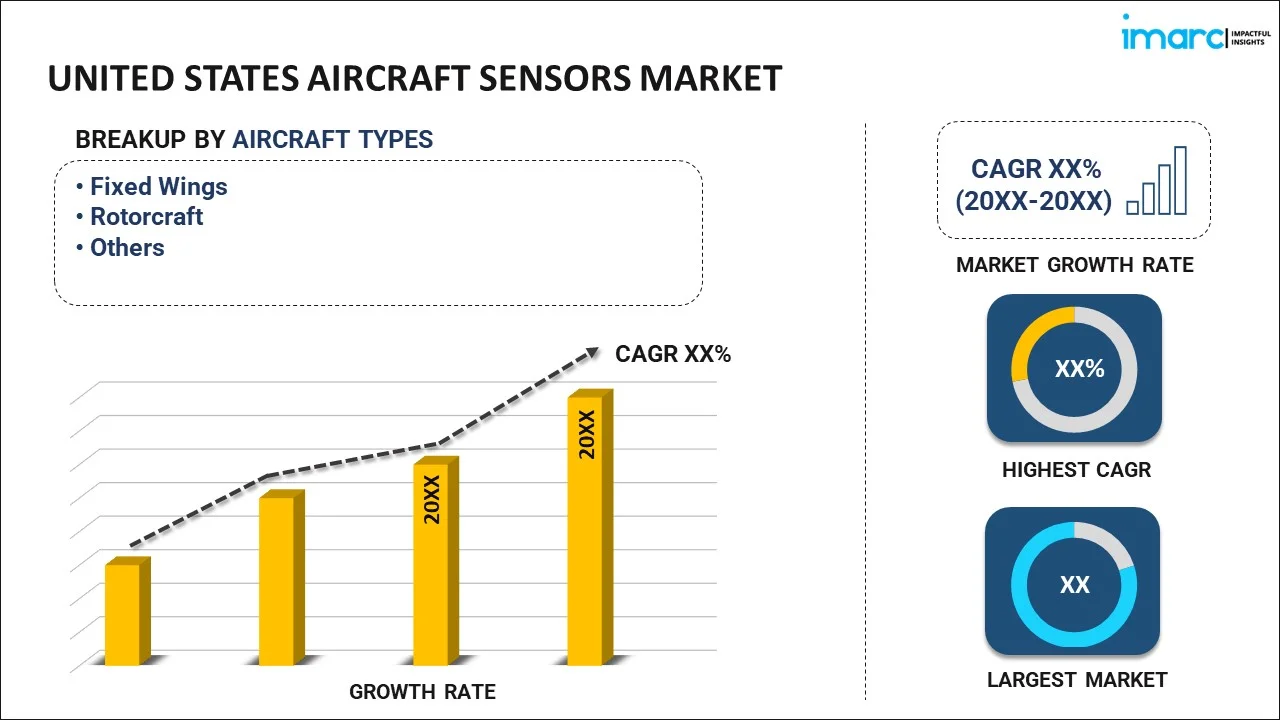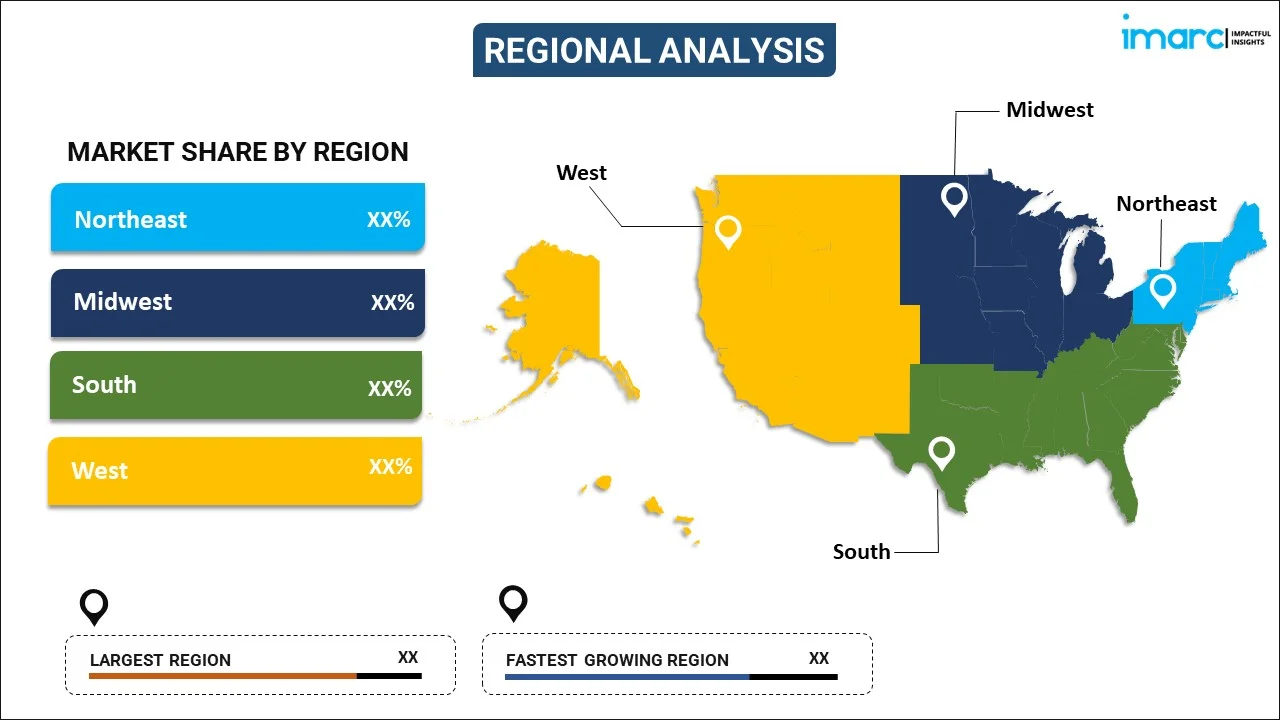
United States Aircraft Sensors Market Report by Aircraft Type (Fixed Wings, Rotorcraft, and Others), Sensor Type (Proximity Sensors, Temperature Sensors, Optical Sensors, Pressure Sensors, Force Sensors, Flow Sensors, Radar Sensors, and Others), Connectivity (Wired Sensors, Wireless Sensors), Application (Flight Decks, Landing Gear Systems, Weapon Systems, Fuel, Hydraulic, and Pneumatic Systems, Engine/Propulsion, Cabin and Cargo Environmental Controls, Aerostructures and Flight Control, and Others), End Use (OEM, Aftermarket), and Region 2025-2033
Market Overview:
The United States aircraft sensors market size is projected to exhibit a growth rate (CAGR) of 5.88% during 2025-2033. The rising aircraft manufacturing, the introduction of advanced aircraft models with sophisticated sensor systems, the increasing applications of unmanned aircraft, and the implementation of aircraft health monitoring systems represent some of the key factors driving the market.
|
Report Attribute
|
Key Statistics
|
|---|---|
|
Base Year
|
2024 |
|
Forecast Years
|
2025-2033 |
|
Historical Years
|
2019-2024
|
| Market Growth Rate (2025-2033) | 5.88% |
Aircraft sensors are critical components used in aviation and aerospace applications to collect and provide data on various aspects of an aircraft's performance, environment, and operating conditions. These sensors play a crucial role in ensuring the safe and efficient operation of aircraft, as well as providing valuable information to pilots, flight crews, and ground control teams. For instance, inertial sensors, including accelerometers and gyroscopes, assist in maintaining precise knowledge of the aircraft's orientation, velocity, and acceleration. They are critical for navigation and autopilot systems. Moreover, sensors like the altimeter and vertical speed indicator provide information about the aircraft's altitude and rate of ascent or descent. They are crucial for maintaining safe flight levels. Besides, weather radar sensors help detect and avoid severe weather conditions, including thunderstorms, turbulence, and precipitation. They provide real-time weather information to pilots for route adjustments. These sensors enable pilots to make informed decisions, provide critical data for aircraft systems, and contribute to overall aviation safety. The continuous advancement of sensor technology plays a significant role in improving the performance and safety of modern aircraft.
United States Aircraft Sensors Market Trends:
The United States is a major hub for aircraft manufacturing, with numerous companies producing commercial, military, and general aviation aircraft. The growth in aircraft production and the introduction of advanced aircraft models with sophisticated sensor systems boost the demand for sensors. In addition, continuous advancements in sensor technology have led to the development of more accurate, reliable, and efficient sensors. Miniaturization, improved sensor materials, and enhanced data processing capabilities contribute to the adoption of sensors in various aircraft systems. Besides, the proliferation of autonomous and unmanned aircraft, including drones and unmanned aerial vehicles (UAVs), relies heavily on sensors for navigation, obstacle detection, and autonomous flight control. The expanding applications of unmanned aircraft drive the demand for specialized sensors. Moreover, emerging technologies such as electric and hybrid-electric propulsion systems, urban air mobility (UAM), and supersonic aircraft development rely on advanced sensors for safety and performance optimization, representing another major growth-inducing factor. Additionally, the use of unmanned aerial systems, including drones and unmanned aircraft, is on the rise in various applications, from surveillance to cargo delivery. These UAS rely heavily on sensors for navigation, collision avoidance, and data collection. Furthermore, the implementation of aircraft health monitoring systems, including sensors that monitor the condition of various aircraft components, reduces maintenance costs and increases operational efficiency is also propelling the market.
United States Aircraft Sensors Market Segmentation:
IMARC Group provides an analysis of the key trends in each segment of the market, along with forecasts at the country level for 2025-2033. Our report has categorized the market based on aircraft type, sensor type, connectivity, application, and end use.
Aircraft Type Insights:

- Fixed Wings
- Rotorcraft
- Others
The report has provided a detailed breakup and analysis of the market based on the aircraft type. This includes fixed wings, rotorcraft, and others.
Sensor Type Insights:
- Proximity Sensors
- Temperature Sensors
- Optical Sensors
- Pressure Sensors
- Force Sensors
- Flow Sensors
- Radar Sensors
- Others
A detailed breakup and analysis of the market based on the sensor type have also been provided in the report. This includes proximity sensors, temperature sensors, optical sensors, pressure sensors, force sensors, flow sensors, radar sensors, and others.
Connectivity Insights:
- Wired Sensors
- Wireless Sensors
The report has provided a detailed breakup and analysis of the market based on the connectivity. This includes wired sensors and wireless sensors.
Application Insights:
- Flight Decks
- Landing Gear Systems
- Weapon Systems
- Fuel, Hydraulic, and Pneumatic Systems
- Engine/Propulsion
- Cabin and Cargo Environmental Controls
- Aerostructures and Flight Control
- Others
A detailed breakup and analysis of the market based on the application have also been provided in the report. This includes flight decks, landing gear systems, weapon systems, fuel, hydraulic, and pneumatic systems, engine/propulsion, cabin and cargo environmental controls, aerostructures and flight control, and others.
End Use Insights:
- OEM
- Aftermarket
The report has provided a detailed breakup and analysis of the market based on the end use. This includes OEM and aftermarket.
Regional Insights:

- Northeast
- Midwest
- South
- West
The report has also provided a comprehensive analysis of all the major regional markets, which include Northeast, Midwest, South, and West.
Competitive Landscape:
The market research report has also provided a comprehensive analysis of the competitive landscape. Competitive analysis such as market structure, key player positioning, top winning strategies, competitive dashboard, and company evaluation quadrant has been covered in the report. Also, detailed profiles of all major companies have been provided.
United States Aircraft Sensors Market Report Coverage:
| Report Features | Details |
|---|---|
| Base Year of the Analysis | 2024 |
| Historical Period | 2019-2024 |
| Forecast Period | 2025-2033 |
| Units | US$ Million |
| Scope of the Report | Exploration of Historical Trends and Market Outlook, Industry Catalysts and Challenges, Segment-Wise Historical and Future Market Assessment:
|
| Aircraft Types Covered | Fixed Wings, Rotorcraft, Others |
| Sensor Types Covered | Proximity Sensors, Temperature Sensors, Optical Sensors, Pressure Sensors, Force Sensors, Flow Sensors, Radar Sensors, Others |
| Connectivities Covered | Wired Sensors, Wireless Sensors |
| Applications Covered | Flight Decks, Landing Gear Systems, Weapon Systems, Fuel, Hydraulic, and Pneumatic Systems, Engine/Propulsion, Cabin and Cargo Environmental Controls, Aerostructures and Flight Control, Others |
| End Uses Covered | OEM, Aftermarket |
| Regions Covered | Northeast, Midwest, South, West |
| Customization Scope | 10% Free Customization |
| Report Price and Purchase Option | Single User License: US$ 3699 Five User License: US$ 4699 Corporate License: US$ 5699 |
| Post-Sale Analyst Support | 10-12 Weeks |
| Delivery Format | PDF and Excel through Email (We can also provide the editable version of the report in PPT/Word format on special request) |
Key Questions Answered in This Report:
- How has the United States aircraft sensors market performed so far and how will it perform in the coming years?
- What has been the impact of COVID-19 on the United States aircraft sensors market?
- What is the breakup of the United States aircraft sensors market on the basis of aircraft type?
- What is the breakup of the United States aircraft sensors market on the basis of sensor type?
- What is the breakup of the United States aircraft sensors market on the basis of connectivity?
- What is the breakup of the United States aircraft sensors market on the basis of application?
- What is the breakup of the United States aircraft sensors market on the basis of end use?
- What are the various stages in the value chain of the United States aircraft sensors market?
- What are the key driving factors and challenges in the United States aircraft sensors?
- What is the structure of the United States aircraft sensors market and who are the key players?
- What is the degree of competition in the United States aircraft sensors market?
Key Benefits for Stakeholders:
- IMARC’s industry report offers a comprehensive quantitative analysis of various market segments, historical and current market trends, market forecasts, and dynamics of the United States aircraft sensors market from 2019-2033.
- The research report provides the latest information on the market drivers, challenges, and opportunities in the United States aircraft sensors market.
- Porter's five forces analysis assist stakeholders in assessing the impact of new entrants, competitive rivalry, supplier power, buyer power, and the threat of substitution. It helps stakeholders to analyze the level of competition within the United States aircraft sensors industry and its attractiveness.
- Competitive landscape allows stakeholders to understand their competitive environment and provides an insight into the current positions of key players in the market.
Need more help?
- Speak to our experienced analysts for insights on the current market scenarios.
- Include additional segments and countries to customize the report as per your requirement.
- Gain an unparalleled competitive advantage in your domain by understanding how to utilize the report and positively impacting your operations and revenue.
- For further assistance, please connect with our analysts.
 Inquire Before Buying
Inquire Before Buying
 Speak to an Analyst
Speak to an Analyst
 Request Brochure
Request Brochure
 Request Customization
Request Customization




.webp)




.webp)












